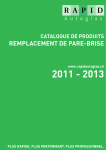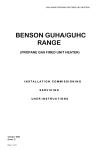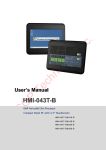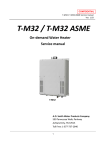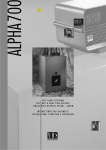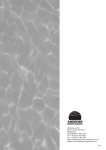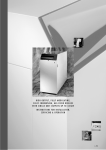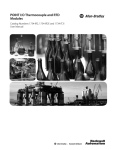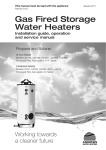Download BENSON HEATING LTD CVO 55 Technical data
Transcript
EM RANGE GAS FIRED Benson Heating HEAT EXCHANGE MODULE RANGE Installation Operation & Servicing Manual BENSON HEATING is a Division of Benson Climate Systems Ltd Ludlow Road Knighton Powys LD7 1LP UK Telephone + 44 (0) 1547 528534 - Facsimile + 44 (0) 1547 520399 -1- EM RANGE GAS FIRED CONTENTS 1,0 1,1 1,2 1,3 Introduction General Product Information Safety Features General Requirements 2,0 2,1 2,2 2,3 2,4 Location & Positioning Gas Supply Electrical Supply Air Supply Flue System 3,0 3,1 3,2 3,3 3,4 3,5 3,6 3,7 Installation Positioning & Siting Flooring & Support Minimum Clearances Flue Installation Gas Installation Electrical Installation EM unit Control Installation 4,0 4,1 4,2 4,3 Commissioning Pre-Test Ignition Hand Over 5,0 5,1 5,2 5,3 Servicing Planned Servicing Servicing of Major Component Parts Servicing – Re-commissioning 6,0 Fault Diagnosis 7,0 Wiring Diagrams 8,0 Technical Data Issue 4 – June 2001 Any reference made to Laws, Standards, Directives , Codes of Practice or other recommendations governing the application and installation of heating appliances and which may be referred to in Brochures, Specifications, Quotations, and Installation, Operation and Maintenance manuals is done so for information and guidance purposes only and should only be considered valid at the time of the publication. Benson Heating cannot be held responsible from any matters arising from the revision to or introduction of new Laws, Standards, Directives, Codes of Practice or other recommendations. -2- EM RANGE GAS FIRED range from 60kW to 700kW, and are suitable for use with natural gas. 1,0 Introduction The Exchange Module range of gas fired process EM units are manufactured by Benson Heating within a strictly controlled quality environment within the parameters of ISO 9001. The EM units within the range have been classed as B23 appliances under BS EN 1020. Key criteria should have been considered at the specification stage so as to ensure that EM units are installed and operated within suitable applications. Benson Heating has taken reasonable and practical steps to ensure that their Exchange Modules are safe and without risk when properly used. These appliances should therefore only be used in the manner and for the purpose for which they were intended, and in accordance with the recommendations detailed herewith. The EM units have been designed, manufactured, assembled, inspected, and tested, with safety and quality in mind, there are certain basic precautions which the installer and user should be aware of, and they are strongly advised to read all the information accompanying the appliance, prior to installation or use. It is the responsibility of the installer, owner, user, or hirer, of such products supplied by Benson Heating, to ensure that they are familiar with the appropriate information/manuals, supplied by the manufacturer, and that they are suitably aware of the purpose of the manuals and the safety instructions. In addition, operators must be suitably trained in the use of the appliance so as to ensure its continued safe and efficient use. The EM units are intended for use within ducted applications, with the EM unit providing the heat source within an air handling system. The units can be mounted at floor or high level. Units which are externally situated must be weatherproofed either within an AHU or by means of a weatherproof enclosure. Each unit must be connected to its own individual open flue of the appropriate size and construction. Each EM unit is fitted with a fully match tested forced draught burner which has been test fired and pre-set prior to despatch. The safety functions of the burner are by way of a fully sequential control box fitted to the burner. 1,2 Safety Features Safety devices, in the form of an air pressure switch, and combined fan and limit thermostat, are fitted to all EM units. Benson Heating has a commitment to continuous improvement, and reserves the right to amend or change the specification of the Exchange Module range. Whilst the manufacturer has made every effort to ensure that the information and data accompanying the unit is accurate and up to date, the manufacturer cannot accept liability for any inadvertent errors or omissions. Air Pressure Switch This safety feature provides constant monitoring of the air pressure produced by the fan unit, whilst the fan unit is operational. If the air pressure drops below a preset level the burner control circuit is broken, and a failsafe and burner lockout situation results. Contained within the text of the manual, the words 'Caution' and 'Warning' are used to highlight certain points. Fan and Limit Thermostat This is wired in series with the air pressure switch and has a dual function; to provide a fan overrun facility in order to dissipate the heat from the heat exchanger on burner shut down, and to provide a failsafe facility in the event that the heat exchanger upper temperature limit should be reached. Caution is used when failure to heed or implement the instruction(s) can lead to premature failure or damage to the appliance or its component parts. Warning is used when failure to heed or implement the instruction(s) can lead to not only component damage, but also to a hazardous situation being created where there is a risk of personal injury. 1,3 General requirements Caution The gas supply to the appliance must be capable of delivering the required minimum dynamic volume. Ensure that the gas service to the appliance carries the correct gas type and that the supply pressure is in accordance with the supply type and pressure stated on the appliance 1,1 General product information The EM range of indirect gas fired forced convection process EM units has an output -3- EM RANGE GAS FIRED The location chosen for the EM unit must allow for the fitting of an effective flue system, it must also offer adequate clearance for the following; the air handling unit and air supply, return air circulation, gas supply, electrical supply, safe working access to all parts of the AHU and EM unit data plate. Ensure that the electrical supply is in accordance with the information contained on the data plate. Installation, commissioning, and servicing must only be carried out by appropriately qualified and competent persons. The appliance must be installed on a flat and level surface made from non-combustible material, which is sufficiently robust to withstand the weight of the AHU and EM unit, and any ancillary equipment. Any combustible material adjacent to the EM unit or flue system must be so placed or shielded so that its surface temperature does not exceed 65oC. Warning Unauthorised modifications to the appliance, or departure from the manufacturers guidance on intended use, or, installation contrary to the manufacturers recommendations may constitute a hazard. The installation of the appliance must meet all of the relevant local, national, and/or international criteria. All EM units are designed to include a pressure relief facility. Care should therefore be taken when siting service connections and controls so that they are well away from the pressure relief vent. Prior to installation the following points should be considered; a) The position of the appliance and air handling unit for the optimum efficient distribution and circulation of warm air b) The position of the appliance relative to the route of the flue c) The position of the appliance relative to the supply of gas d) The position of the appliance and air handling unit relative to the electrical services and any additional controls. e) The position of the appliance and air handling unit relative to the supply of fresh air f) The position of the appliance and air handling unit relative to the service and maintenance requirements Warning Under no circumstances must the pressure relief be restricted, blocked, or have the free exit of exhaust gas impaired or re-directed. Where anti-vibration mountings are used, usually to reduce noise levels, it is essential that the gas, electrical, flue, and duct-work connections are of a flexible type, so as to insulate the unit and thereby prevent possible damage through transmitted vibration. 2,1 Gas supply Caution The EM unit must not be installed within an area where the conditions are unsuitable, e.g. where the atmosphere is highly corrosive, has a high degree of salinity, or where high wind velocities may affect burner operation. Suitable protection should be provided for the appliance when it is located in a position where it may be susceptible to external mechanical damage from; for example, fork lift trucks, overhead cranes etc. The Exchange Module range is manufactured and supplied with burners pre-set for use with natural gas to I2H (G20). The EM unit must be compatible with the gas supply, and each EM must be installed with a separate approved isolating gas cock positioned adjacent to and upstream of the union between the service pipe and the appliance. Service and Installation pipe work must be of a diameter equal to or greater than the inlet 2,0 Location/positioning connection on the EM unit, all joints must be sealed using an approved sealing compound, and the system purged and tested for soundness in accordance with accepted procedures. Indirect fired EM units must not be located in hazardous areas, however, it is permissible for the EM unit to supply air to such areas. The EM unit must not be installed within an environment where there is a high concentration of chlorides, fluorides, salts, or other aggressive or volatile chemicals/compounds. Nor should the EM unit be positioned where the burner could be adversely affected by high winds or draughts. 2,2 Electrical supply Wiring external to the EM unit must be installed in accordance with any local, national, and/or international requirements. A selection of wiring diagrams are provided under section 7 of this manual. Other wiring options are available on request -4- EM RANGE GAS FIRED Position of vent Area of vent direct to outside The means of connection to the main electrical supply must allow for complete electrical isolation of the appliance, furthermore, in the case of units wired for a three phase supply, the supply should only be used to serve the unit and respective air handling system. The position of the isolation switch must be such that it is adjacent to the appliance and easily accessible at all times. Additionally the isolator itself must have a contact separation of not less than 3mm. The main isolator fuse ratings must be as per detailed on the appliance data plate. Low level (inlet) 540cm2 + 4,5cm2 per kW of rated input per EM unit High level (outlet) 270cm2 + 2,25cm2 per kW of rated input per EM unit Caution Systems of ventilation that employ mechanical extraction and natural inlet must not be used. Furthermore, where the air supply is by way of a mechanical means the inlet must be positioned at low level and capable of providing the required minimum throughput. The natural extraction air vents must have a minimum area as previously detailed, and it is recommended that natural extraction vents are situated at high level. Additionally, an automatic control interlocked to the burner must be fitted to ensure burner shutdown in the event of air flow failure or restriction. Warning Ensure that the electric and gas supplies are turned off before any electrical work is carried out on the EM unit. Ensure that wiring cannot make contact with any surfaces liable to be subject to high temperatures, and where the insulation of the wiring could be impaired as a result of such contact. All EM units must be earthed. If the EM unit is to be installed within its own building or plant room, the above details do still apply, as does the requirement for minimum space. Caution The main electrical supply must not be switched off or disconnected as a method for stopping the EM unit, the exception to this is in an emergency, or during servicing, when the heat exchanger has been allowed to cool sufficiently to prevent any damage from occurring. 2,4 Flue system Warning It is essential that the products of combustion are flued to the outside of the building. Each EM unit must have its own separate flue, with a flue diameter of not less than the flue spigot fitted to the EM unit. The minimum vertical length of flue must not be less than 1m. The flue must be constructed using the appropriate products and must rise vertically, and terminate with an approved cowl. 2,3 Air supply Provision must be made for the existence of an air supply for both combustion and ventilation. It is a requirement that the area where the air EM unit is located must have a permanent air vent of negligible resistance direct to the outside air. Such air vents must be positioned so as not to become blocked or flooded, nor should they be placed so as to introduce undesirable matter (e.g. flammable, volatile, or aggressive chemicals/compounds or potentially hazardous or harmful substances) either direct from the outside, or through their proximity to an adjacent extraction system. The position of the flue terminal must be in accordance with those detailed within BS 5440 part 1, for units rated at less than 60kW, or BS 6644 for units rated at more than 60kW. The manufacturers recommendation is that the flue terminal must be positioned so as to be 1m higher than any other object or structure within 3m of the flue terminal. The criteria necessary for establishing the minimum size of natural vents is detailed in the following table based upon BS 5440 part 2. An alternative reference would be BS 6230 1991. Warning The amount of draw within the flue and combustion circuit can influence combustion. It is therefore recommended that the flue structure is checked to ensure that the combustion chamber and flue pressures are within the limits detailed by the manufacturer. It should be noted that where mechanical ventilation is used it is a requirement that the inlet is of the mechanical type, and the outlet is either mechanical or natural. -5- EM RANGE GAS FIRED Not less than 600mm Not less than 600mm Parapet Greater than 1500mm Flat roof with parapet Not less than 600mm H1 H2 Less than 10 h2 Less than 10 h1 Greater than 1500mm Flat roof envelope method H2 Not less than 250mm Structure Structure H1 Greater than 10 h1 2 Flat roof where the flue height is more than 10 Heights (H) away from all structures -6- EM RANGE GAS FIRED Not less than 600mm Structure Less than 1500mm Flat roof with flue close to parapet Not less than 600mm Not less than 250mm Flat roof with no parapet Not less than 600mm Structure Less than 1500mm Flat roof with structure close to flue outlet -7- EM RANGE GAS FIRED Not less than 600mm Not less than 600mm Not greater than 45° Pitched roof not greater than 45° Less than 1500mm Not less than 600mm Dormer window Pitched roof chimney within 1.5m from dormer window measured horizontally -8- EM RANGE GAS FIRED Not less than 1000mm Not less than 1000mm Greater than 45° Pitched roof exceeding 45° Termination on ridge Not less than 600mm Less than 45° Pitched roof internal route not exceeding 45° and ridge termination Not less than 600mm Not less than 1000mm Dormer window Pitched roof chimney within 1.5m from dormer window measured horizontal. -9- EM RANGE GAS FIRED 3,1 Positioning and siting Combustion Chamber Internal Resistance EM60 - EM88 EM117 - EM175 EM235 - EM301 EM375 EM440 EM525 - EM600 EM700 It is advisable that when positioning the appliance the lifting eyes are used, thereby reducing the risk of inadvertent damage. 0.4 mbar 0.6 mbar 0.9 mbar 0.6 mbar 0.9 mbar 0.7 mbar 1.1 mbar 3,2 Flooring and support The EM unit must be installed on a level non combustible surface capable of supporting the weight of the EM unit and any ancillary equipment. Warning Special flue configurations such as those featuring dilution systems and fan assisted flues can only be used if they do not adversely effect the combustion. The resistance figures detailed in section 8 must therefore be adhered to. 3,3 Minimum clearances Sufficient clearance must be allowed to enable installation, commissioning and servicing to be carried out safely and effectively. The manufacturer recommends that a clearance of at least 1m at the front and the back of the EM unit so as to allow burner servicing (on front panel) and heat exchanger tube cleaning (on the back panel). Horizontal runs must be kept to an absolute minimum, and wherever possible the flue should rise vertically. If this is not possible 45o bends should be used. If a horizontal run is necessary it should be installed so as to rise by 5o and should be followed by a vertical rise of at least twice that of the horizontal run. 3,4 Flue Installation The flue must feature an approved terminal, and the flue system should be effectively sealed. An integral condensate tee is fitted to all Exchange Modules, thereby allowing the flue to connect directly into the appliance. The design of the flue must ensure that it can be disconnected to allow for cleaning and servicing, furthermore, all of the flue section joint sockets must face upwards, and the seal between the sections achieved through mechanical joints or through the use of approved caulking string and grout. The design and construction of the flue must also take account for the provision of external flue support for installations with long flue runs . Warning Care should be taken when siting the AHU as the flue temperature of the condensate tee may be in excess of 350° C . An optional flue guard is available as an accessory Where condensation is likely to be a problem provision should be made, preferably at the design stage. All EM units are fitted with a drain point at the bottom of the condensate tee. The manufacturer recommends that on units fitted with high-low or modulating burners the drain facility is connected so as to allow condensates to drain freely. 3,0 Installation Note It is strongly advised that the installer reads and is familiar with Section 2 and Section 3 of this manual prior to starting any installation work. It is a requirement that only qualified and competent personnel may undertake installation, commissioning, and servicing. 3,5 Gas Installation Warning If a gas leak is suspected, all potential sources of ignition must be extinguished, gas supply cocks closed to isolate the leak, doors and windows opened to allow the dissipation of the gas to occur, and the gas supplier informed immediately. Caution Particular attention should be paid to the ventilation requirements of small plant rooms when installing AH units. The radiated heat from the flue exit ducts may cause the burner compartment ambient temperature to exceed the 60° C maximum operating temperature for the burner if the compartment ventilation is inadequate Never search for gas leaks with a naked flame. Pipe work and meters must be sized so as to take into account the required dynamic volume for - 10 - EM RANGE GAS FIRED 3,9 EM unit Control Installation the EM unit and any other plant reliant upon the supply. All EM units are manufactured with the fan and limit thermostat, air pressure switch, and burner pre-wired and installed. It is the responsibility of the installer to make the appropriate connections, and to supply and install suitable ancillary controls to ensure that the unit performs satisfactorily, for example, room thermostat, time clock, building management systems, process management systems etc,. Service pipe work must terminate at an approved gas cock, and be adjacent to the position of the appliance. The connection to the EM unit can be made by way of either an approved flexible coupling, or rigid connection. Threaded connections must comply with ISO 228/1 or ISO 7/1. The diameter of the pipe work from the cock to the burner connection must not be less than the diameter of the burner connection inlet. Warning Ancillary controls must not be wired so that they may override any of the safety controls or safety devices. The installation must be purged and tested for soundness prior to commissioning in accordance with the current approved methods. Caution It is the responsibility of other suppliers to ensure that thermostat/sensor positioning and the controls package in general, allows for satisfactory operation of the EM unit. Room thermostats must be positioned so as not to be directly within the airflow from the appliance, nor should the thermostats be positioned so that they are subject to elevated temperatures associated with strong or direct sunlight. Ideally the thermostats should be positioned so that they are approximately 1.6m above floor level within the area to be heated by the EM unit. Caution Excess gas pressure can damage the control valves within the gas train. Insufficient gas pressure can cause nuisance burner lockouts. The gas supply at the inlet to the gas train should be set at 22.5 millibar. 3,6 Electrical Installation Reference should be made to the wiring diagram(s) contained later in this manual prior to installation or connection to the electrical supply. Note The wiring diagram number can be found on the data plate 4,0 Commissioning The air delivery system must have already been fully commissioned and balanced prior to the commissioning of the EM unit, thereby ensuring that required air flow characteristics are in accordance with those recommended for the EM unit. The electrical supply must be as specified and suitable for the EM unit, and must be run within conduit to a point adjacent to the EM unit, and be terminated to provide an isolation point that will prevent remote or inadvertent use. All EM units are supplied fused and pre-wired, all must be earthed. Final connections for the air handling unit and external controls must be completed on site, and must be carried out according to the appropriate regulations. Warning The maximum and minimum air volumes detailed as follows must be adhered to. Airflow Volumes (m3/s) On EM units fitted with High-low or modulating burners it is a requirement that the high flame and modulating flame signal cables are sufficiently protected and screened so as to prevent any external influence associated with induced voltages etc. EM60 EM88 EM117 EM150 EM175 EM235 EM301 EM375 EM440 EM525 EM600 EM700 Separate user information is provided for the burner, and forms part of the product information pack which accompanies every EM unit when despatched. Warning Always isolate from mains electrical supply before commencing work on the EM unit. min max 0.9 1.2 2.2 2.4 2.4 3.0 3.2 6.0 7.0 8.0 9.5 11.3 1.7 2.3 3.5 4.5 5.3 7.0 7.7 11.2 12.5 15.8 17.0 18.9 Caution The air delivery system must have been fully commissioned and balanced before the EM unit - 11 - EM RANGE GAS FIRED can be commissioned. A fan overrun facility must have been programmed into the fan controls so as to allow for residual heat to be dissipated at the end of a heating cycle. (b) Ensure that the gas supply is turned off (c) Check that all panels and fasteners are secure and in place Failure to provide this facility will result in frequent overheat situations which over prolonged periods can compromise the longevity of the EM unit and its controls. The residual heat can also damage the flue system. (d) Check that the EM and air handling unit is installed so that it is square and that the support is adequate (e) Ensure that warm air delivery outlets are open and that ducting is adequately supported Further, if fire dampers are fitted within the ducting these can be activated by the residual heat if insufficient fan overrun time has been allowed for and programmed in. (f) Ensure that if filter assemblies are fitted that they are secure and correctly located (g) Check that air inlets are clear and that return air paths are adequate Note In applications where fire alarm systems are integrated with the AHU/EM controls it should be noted that when these fire systems are activated they usually cut power to the AHU and EM unit resulting in residual heat build up (when activated during a heating cycle or within the fan overrun time). This will cause overheat situations and can also activate duct mounted fire dampers. Frequent overheat situations can compromise the longevity of the EM unit and its controls. (h) Ensure that the flue is secure, adequately supported, and that the various joints are properly sealed (i) Check that condensate trap and drain facilities are adequate (j) Check that there is provision for flue gas sampling and that this sample point can be plugged and sealed after commissioning It is a requirement that only suitably qualified and competent personnel are allowed to undertake the commissioning of the appliance. It is also strongly recommended that prior to commissioning the engineer familiarises himself with the information contained within the information pack that accompanies the EM unit, the EM unit/air handling system itself, and becomes familiar with the specific installation/application. The following checks should be carried out after the familiarisation process. (k) Check that fan and limit stat settings have not been disturbed (l) Ensure that the burner is securely attached to the EM unit (m) Test for electrical earth continuity between the appliance, gas pipe work, and mains supply (n) Turn the main electrical supply to on, select the following settings (it should be noted that as the controls package is usually supplied by others the actual settings may vary from those detailed as follows, the rationale is to check that airflow characteristics are in accordance with those detailed previously) on/off - on heat/ventilation - ventilation manual/automatic - manual The fan will start enabling the airflow direction etc to be verified Warning All EM units undergo a rigorous test programme prior to being despatched, whilst such a programme does involve pre-commissioning and setting up the EM unit to operate within its designed operational limits, this does not mean that on site commissioning is less important than might otherwise be the case. 4,1 Commissioning - Pretest (o) Check that the volumetric air flow over the combustion chamber and heat exchanger is as recommended and is sufficient to satisfy the air pressure switch. On completion of airflow tests reset on/off switch to the off position The air system and controls must have been commissioned and proven prior to commissioning the EM unit. Check to ensure electrical safety, and inspect and purge the gas train installation, testing for soundness. (a) Ensure that the electrical supply is turned off (p) Set room thermostat and time clock to on positions (q) Turn mains electrical supply to off - 12 - EM RANGE GAS FIRED 4,2 Commissioning - Ignition Warning If burner ignition is not satisfactorily accomplished, commissioning must not proceed until the reason or fault has been identified and rectified, if necessary by reference to the separate burner information or to section 6,0 of this manual. Warning Do not proceed with commissioning unless all the criteria detailed within sections 4,0 and 4,1 have been satisfied. (a) Ensure that the electrical supply is turned to off (j) Repeat steps 4,2 c,a, (b) Ensure that the gas supply is turned to off (k) Re-check all connections and joints for gas soundness using an approved leak detection fluid (c) Select the following control settings on/off - off heat/ventilation - heat manual/automatic - automatic (l) Attach manometers to check pressure settings (d) Turn main electrical supply to on (m) Repeat steps 4,2 d,e,f, allowing the EM unit to reach thermal equilibrium (e) Select on position for on/off control (n) Check pressure settings are in line with the technical data (if adjustment is necessary refer to separate burner information) (f) Check for the following burner sequence Note It is strongly recommended that the separate manual concerning the operational details of the burner supplied with the EM unit as part of the information package is studied prior to firing the burner. Note The figures quoted in section 8 are independent test figures based upon zero flue resistance. (o) Adjust room thermostat to its highest setting, and allow the EM unit to continue to fire Time intervals within the ignition sequence will vary slightly from one model to another. Time interval (p) Gradually reduce the temperature setting on the room thermostat until the burner shuts down, and then gradually increase the temperature setting on the thermostat until heat is called for, and the burner automatically re-fires Operation 1 - 5secs If applicable, combustion air damper is actuated, fan motor starts purge cycle... (q) Re-set time clock to a minimum off period, checking that the burner shuts down, and then automatically re-lights once the minimum off period has elapsed 2 - 40secs Pilot valve opens, ignition transformer provides spark for pilot ignition... either 3 - 40secs Ignition failure caused by gas starvation resulting in burner lock-out/shutdown... Note If specific temperature rise characteristics are a requirement then these should be noted, and the burner rated accordingly prior to flue gas analysis. (g) Clear burner lockout using burner reset function (r) Undertake flue gas analysis and efficiency checks across the operational range using approved and calibrated apparatus. (h) Set EM unit control on/off switch to off position Note All EM units are test fired and precommissioned as part of the manufacturing process, if however, during on site commissioning the data are found not to be in accordance with the manufacturers data, then the following course of action is recommended; (i) Open gas cocks and repeat steps 4,1 q, and 4,2 c,e,f, or 3 - 40secs ignition... Pilot ignition, Burner 4 - 60secs complete. Burner ignition cycle • Re-check all readings and calculations - 13 - EM RANGE GAS FIRED • Adjust burner as per manufacturers instructions • Consult Benson Heating Technical Department In order to maintain the efficient operation of the Exchange Module and its accompanying air handling unit it is recommended that the following planned servicing and preventative maintenance programme is adopted by the user. (s) Complete commissioning report and provide operating instructions for the user, high-light the fact that the manufacturer recommends that in the interests of safety and efficiency the EM unit is serviced on a regular basis by qualified and competent persons. Quarterly Inspection • Visual inspection of the burner • Clean and check ionisation probes • Check air pressure switch is operational Bi-Annual Inspection As per quarterly inspection, plus... • Combustion check (t) Set all controls to the requirements of the user 4,3 Commissioning - hand over Annual Inspection As per half year inspection, plus... • Combustion circuit inspection and cleaning • Electrical connections • Volumetric air test • Gas Supply • Burner • Flue • Report (a) Upon full and satisfactory completion of commissioning, a record of commissioning information (contact, date, etc) should be left with the unit. (b) The commissioning engineer must ensure that the user is familiar with the safe and efficient use of the appliance, detailing the function of all controls, and main components 5,2 Servicing Procedure - Major Component Parts (c) The user should be made aware of the following in particular Flue A visual inspection should be carried out to ensure that the flue remains adequately supported, both internally as well as externally, and that the various joints are effectively sealed. Inspection covers, where fitted, should be removed and the flue checked to see whether cleaning is required. If inspection covers are not fitted the gas exit duct and flue spigot will provide not only an indication of the cleanliness of the flue, but will also enable access for cleaning. The flue should also be checked for signs of internal and external corrosion. The presence of the flue terminal should be checked as should the effectiveness of the seal between the roof and the flue. • Lighting, shutdown, and operational information. • Safety features, data plate, and labelling. • The requirement for regular inspection especially if the EM unit is within a more demanding environment - and the need for regular servicing, carried out by competent and qualified persons. 5,0 Servicing Warning Servicing must be carried out on a regular basis, the maximum interval between services being 1 year or 1000 hours. It is a requirement that only suitably qualified and competent persons are allowed to undertake servicing. If a condensate trap and drain facility is fitted this should be checked to ensure that it continues to function correctly, and the drainage of condensates is not impaired. Before any maintenance or servicing work is carried out, the appliance must be shut down and allowed to cool. The gas and electric supplies must also be turned off at the gas cock and isolator respectively. Heat Exchanger The heat exchanger requires a visual inspection at least once per year, this should be accompanied by cleaning. It is recommended that a flue brush and vacuum cleaner are used to facilitate this. Access to the heat exchanger is gained through the removal of the inspection covers on the back panel and heat exchanger tube bank. Servicing and cleaning should be performed as follows. Warning Only approved spare/replacement parts can be fitted, failure to comply with this can compromise the safe and efficient running of the EM unit, and can also invalidate any warranty claim. 5,1 Planned Servicing - 14 - EM RANGE GAS FIRED checked to ensure that no stray strands are bridging terminals. Electrical continuity should also be checked. (a) Remove brass nuts and cover from heat exchanger end assembly to expose heat exchanger tubes. (b) Remove any accumulated deposits from the tubes by pushing through the full length with a flue brush. (c) The flue brush should be withdrawn so as to pull any deposits back into the bottom of the EM unit and flue box where they can then be removed by using a vacuum cleaner. (d) Particular attention should be paid to the upper internal surfaces of the tubes, where through convection heavier deposition is likely to occur. (e) Any deposits which may have accumulated within the combustion chamber can be removed with a vacuum cleaner once the burner is removed. Gas Supply The gas supply pipe work and fittings should be inspected to ensure that they are free from corrosion, and to ensure that where brackets have been fitted these remain secure and offer adequate support. The system should be soundness tested. Burner Service requirements for the burner are covered in the separate manual prepared by the burner manufacturer, and which is provided within the information pack supplied with the EM unit. Warning It is most important that the burner is serviced regularly and in accordance with the manufacturers instructions. Prolonged operation of the burner outside the tolerance of its original setting can compromise the longevity of the combustion circuit, and can, in extreme circumstances result hazardous situations being created. Note It is most important that a build up of deposits is not allowed to occur as this can have an adverse effect upon the efficiency of the EM unit and reduce the life of the heat exchanger. (f) The heat exchanger and combustion chamber should be visually inspected for signs of splits, cracks, and distortion. (g) All gaskets should be checked to ensure that they continue to provide a gas tight seal, if there is an element of doubt then they should be replaced. Report A full and detailed service report should be prepared, it is advised that the report should not be completed until the EM unit has been recommissioned, where upon the completed report can then be explained in detail in the presence of the user. Caution The seal between the inspection cover and the heat exchanger tube bank must be maintained. Any air leakage from the high pressure airflow into the chamber can adversely affect combustion and will lead to premature failure of the combustion chamber and/or heat exchanger. It is recommended that this seal is replaced each time the inspection cover is removed. 5,3 Service Re-commissioning The appliance should be re-commissioned as follows; this must be regarded as a necessary part of the EM unit service: (a) As Section 4,1 (b) As Section 4,2 (c) As Section 4,3 (h) The condensate drain points should be checked to ensure that they are free from blockages or obstructions. 6,0 Fault Diagnosis Warning If the condition or integrity of the combustion chamber or heat exchanger gives cause for concern the Service Department at Benson Heating should be advised pending a more detailed examination. If it is suspected that the combustion chamber or heat exchanger is holed or split a full examination combined with combustion analysis should take place as soon as is possible. Due to the variety of applications where EM units are successfully used it is impossible for Benson Heating to create representative fault diagnostics for each and every application or eventuality. Technical support is available through contact via The Service Dept at Benson Heating (Telephone + 44 (0) 1547 528 534). In the interests of health and safety the manufacturer is keen to offer technical assistance and support when or wherever this maybe required. Further information concerning Electrical Supply All connections must be checked to ensure that they are secure, and free from corrosion. Terminals and connections should also be - 15 - EM RANGE GAS FIRED fault diagnostics is contained within the burner manual which is supplied as part of the information pack with each EM unit. The following fault diagnosis chart is therefore only an initial guide Check On/Off Switch No Power Check Isolator Check Fuses Burner fails to Run Check for Lockout Check Thermostat No Demand Check Timer Check Air Pressure Switch Check Overheat Check Voltage Check Flame Probe Check Control Box and Burner Check Gas Supply Check Burner Motor Ensure Gas Cock is Open Fan Starts but Burner goes to Lockout Air in Gas Feed Faulty Air Pressure Switch Ignition Failure Ensure start Gas Valve Opens Purge Air Check as per Burner Manual Check control Box Faulty Ignition Transformer Faulty Electrode Check HT Lead and Connector Check Gap Check Insulation Control Box Fault - 16 - EM RANGE GAS FIRED Check Gas supply Excess Air Check that flue Gas CO is as advised Adjust damper to suit Burner lights on start gas but fails to establish main flame Low Gas Pressure Check Inlet Gas Pressure Signal Check Main Burner Gas Pressure Check Flame Probe Position Check Burner Check Low Flame Switch is On Check Controls Check Control Insufficient air passing over Heat Exchanger Check air to inlet is not restricted Resistance too high Burner starts but excess temperature shuts down the burner on overheat lockout Check Slow Acting Valve Remove Obstruction Clean Filters Check Outlet Grilles are Open Fan Slipping High Return (inlet ) Air Temperature Impellor Slipping Faulty or incorrectly set Fan Limit Control - 17 - Check for warm air short circuit to Air Inlet Reset Fan Limit Control Refer to Air Handling Unit Manual Reset Grilles away from adjacent walls EM RANGE GAS FIRED 7.0 Wiring Diagrams 20-33-660 EM 175 / 235 / 301 RIELLO RS28.1 ON / OFF 230V/3ph/50Hz - 18 - EM RANGE GAS FIRED 20-33-661 EM 265 / 300 RIELLO RS38.1 ON / OFF 230V/3ph/50Hz - 19 - EM RANGE GAS FIRED 20-33-666 EM 235/301 RIELLO RS28 EM375 RIELLO RS38 (nonstd) HI / LO 230V/3ph/50Hz - 20 - EM RANGE GAS FIRED 20-33-667 EM 375 RIELLO RS38 EM440 RIELLO RS50 HI / LO 415/3ph/50Hz - 21 - EM RANGE GAS FIRED 20-33-680 EM235/301 RIELLO RS28M GAS MODULATING 230V/1PH/50Hz - 22 - EM RANGE GAS FIRED 20-41-210 EM375/ 440/600/700 RIELLO RS38M / 50M / 70M /100M 415/3PH/50Hz Burner supply - 23 - EM RANGE GAS FIRED 20-41-211 EM525/600 RIELLO RS70 EM700 RIELLO RS100 HI/LO 415/3PH/50Hz - 24 - EM RANGE GAS FIRED 20-46-157 EM60,88,117,150, RIELLO GS10 / 20 BURNER ON/OFF 230V/1PH/50Hz - 25 - EM RANGE GAS FIRED 20-46-213 EM60 to 175 RIELLO GS10D /20D GAS FIRED HI/LO 230V/1PH/50Hz - 26 - EM RANGE GAS FIRED 20-46-374 EM 60-175 RIELLO GS10/GS20M GAS FIRED MODULATING - 27 - EM RANGE GAS FIRED 8.0 Technical Data MODEL HEAT OUTPUT HEAT INPUT (GROSS) GAS CONSUMPTION BURNER TYPE BURNER HEAD PRESSURE Mbar (zero resistance cover fitted) MINIMUM GAS INLET PRESSURE HEAD SETTING (zero flue resistance) AIR SHUTTER SET (zero flue resistance) GAS CONNECTION RESISTANCE @ MAXIMUM AIR RESISTANCE @ MINIMUM AIR MAXIMUM AIR VOLUME MINIMUM AIR VOLUME MAXIMUM TEMPERATURE RISE SOUND LEVEL COMBUSTION CHAMBER (press) FLUE RESISTANCE FLUE DIAMETER CONTROLS INPUT ELECTRICAL SUPPLY FUSE RATING (UNIT) RUNNING CURRENT CABLE SIZE CO CO2 FLUE GAS Vol @ Full load FLUE TEMP ( GROSS ) AIR PRESS SETTING FAN/LIMIT SET (std) FAN/LIMIT (hi temp) NETT WEIGHT kW/hr kW/hr m3/hr RIELLO On/Off Hi/Lo m/bar Ins WG Number EM60 60.0 77.5 7.23 R40 GS10 EM88 88.0 113.5 10.59 R40 GS10 4.0/1.8 17.5 7 EM117 117.0 151.0 14.08 R40 GS20 EM150 150.0 193.5 18.05 R40 GS20 4.9/2.0 17.5 7 17.5 7 17.5 7 Number BSP Pascals 1 /2 1 /2 3 /4 3 /4 165 165 190 350 m3/sec 2.25 2.25 3.5 5.1 m3/sec 0.91 1.33 1.77 2.27 Deg C Dba 55 55 55 55 m/bar Min m/bar Max m/bar mm Vdc Standard Amps Amps mm2 Ppm % 0.4 -0.2 +0.6 150 10 230V/1ph/50Hz 6 3 1.5 <100 9% 0.4 -0.2 +0.6 175 10 230V/1ph/50Hz 6 3 1.5 <100 9% 0.6 -0.2 +0.6 175 10 230V/1ph/50Hz 6 3 1.5 <100 9% 0.6 -0.2 +0.6 175 10 230V/1ph/50Hz 6 3 1.5 <100 9% 250 350 315 390 0.4 30-50-90 30-50-125 191 0.4 30-50-90 30-50-125 191 0.4 30-50-90 30-50-125 305 0.4 30-50-90 30-50-125 305 Pascals m3/hr @ 20o C Ambient m/bar Deg C Deg C KG - 28 - EM RANGE GAS FIRED MODEL HEAT OUTPUT HEAT INPUT (GROSS) GAS CONSUMPTION BURNER TYPE BURNER HEAD PRESSURE Mbar (zero resistance cover fitted) MINIMUM GAS INLET PRESSURE HEAD SETTING (zero flue resistance) AIR SHUTTER SET (zero flue resistance) GAS CONNECTION RESISTANCE @ MAXIMUM AIR RESISTANCE @ MINIMUM AIR MAXIMUM AIR VOLUME MINIMUM AIR VOLUME MAXIMUM TEMPERATURE RISE SOUND LEVEL COMBUSTION CHAMBER (press) FLUE RESISTANCE FLUE DIAMETER CONTROLS INPUT ELECTRICAL SUPPLY FUSE RATING (UNIT) RUNNING CURRENT CABLE SIZE CO CO2 FLUE GAS Vol @ Full load FLUE TEMP ( GROSS ) AIR PRESS SETTING FAN/LIMIT SET (std) FAN/LIMIT (hi temp) NETT WEIGHT EM301 301 376.3 35.1 RS 28 EM375 375 480.0 44.8 RS 38 17.5 7 0.8 / 8.0 17.5 7 10.4 / 4.6 2.0 / 10.4 17.5 7 1.6 / 9.4 17.5 7 BSP 1" 1¼ 1¼ 1½ Pascals 350 200 240 250 m3/sec 5.1 6.75 7.75 11.25 m3/sec 2.65 3.55 4.5 5.5 Deg C Dba 55 55 55 55 m/bar Min m/bar Max m/bar mm Vdc Standard Amps Amps mm2 Ppm % 0.6 -0.4 +1.6 175 10 230V/1ph/50Hz 6 3 1.5 <100 9% 0.9 -0.4 +1.6 225 10 230V/1ph/50Hz 10 6 1.5 <100 9% 0.9 -0.4 +1.6 225 10 230V/1ph/50Hz 10 6 1.5 <100 9% 0.6 -0.4 +1.6 250 10 230V/1ph/50Hz 10 6 1.5 <100 9% 360 300 345 330 0.4 30-50-90 30-50-125 305 0.4 30-50-90 30-50-125 435 0.4 30-50-90 30-50-125 435 0.4 30-50-90 30-50-125 800 kW/hr kW/hr m3/h RIELLO On/Off Hi/Lo Modulating m/bar Ins WG Number EM175 175 225.3 21.02 R40 GS20S EM235 235 293.8 27.4 RS 28.1 8.3 Number Pascals m3/hr @ 20o C Ambient m/bar Deg C Deg C KG - 29 - EM RANGE GAS FIRED MODEL HEAT OUTPUT HEAT INPUT (GROSS) GAS CONSUMPTION BURNER TYPE BURNER HEAD PRESSURE Mbar (zero resistance cover fitted) MINIMUM GAS INLET PRESSURE HEAD SETTING (zero flue resistance) AIR SHUTTER SET (zero flue resistance) GAS CONNECTION RESISTANCE @ MAXIMUM AIR RESISTANCE @ MINIMUM AIR MAXIMUM AIR VOLUME MINIMUM AIR VOLUME MAXIMUM TEMPERATURE RISE SOUND LEVEL COMBUSTION CHAMBER (press) FLUE RESISTANCE FLUE DIAMETER CONTROLS INPUT ELECTRICAL SUPPLY FUSE RATING (UNIT) RUNNING CURRENT CABLE SIZE CO CO2 FLUE GAS Vol @ Full load FLUE TEMP ( GROSS ) AIR PRESS SETTING FAN/LIMIT SET (std) FAN/LIMIT (hi temp) NETT WEIGHT kW/hr kW/hr m3/hr RIELLO On/Off Hi/Lo Modulating m/bar Ins WG Number EM440 440 550 51.3 RS 50 EM525 525 656 61.2 RS 70 EM600 600 750.3 70.0 RS 70 EM700 700 875.8 81.7 RS 100 7.8 / 3.1 6.4 / 0.8 17.5 7 0.5 / 8.0 17.5 7 17.5 7 10.4 / 3.8 10.4 / 1.6 17.5 7 BSP 2" 2" 2" 2" Pascals 275 225 250 275 m3/sec 12.1 16.9 17.9 18.9 m3/sec 6.65 8.1 9.1 10.6 Deg C Dba 55 55 55 55 m/bar Min m/bar Max m/bar mm Vdc Standard Amps Amps mm2 Ppm % 0.9 -0.4 +1.6 250 10 230V/1ph/50Hz 10 6 1.5 <100 9% 0.7 -0.4 +1.6 350 10 230V/1ph/50Hz 10 6 1.5 <100 9% 0.7 -0.4 +1.6 350 10 1.1 -0.4 +1.6 350 10 350 0.4 30-50-90 30-50-125 800 Number Pascals m3/hr @ 20o C Ambient m/bar Deg C Deg C KG - 30 - 415V/3ph/50Hz 415V/3ph/50Hz 10 6 1.5 <100 9% 10 6 1.5 <100 9% 250 270 300 0.4 30-50-90 30-50-125 1765 0.4 30-50-90 30-50-125 1765 0.4 30-50-90 30-50-125 1765 EM RANGE GAS FIRED - 31 -































